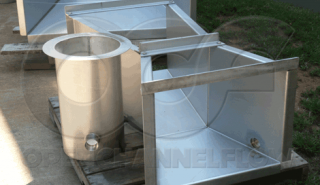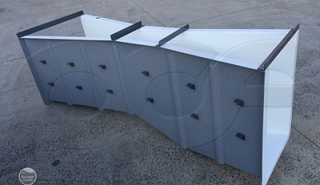Less well known than their more numerous Rectangular throated brethren, Trapezoidal Cutthroat flumes are a class of (3) flumes that combine the low flow sensitivity of the Trapezoidal flume with the simple, throatless design of the Cutthroat flume.
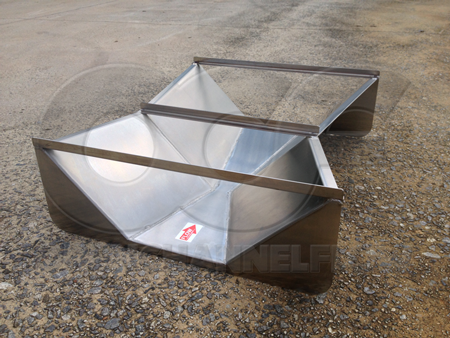
Flume Design
Simple of form and construction, Trapezoidal Cutthroat flumes have flat floors, which allow for their placement onto existing channel beds, without the need for extensive excavation. The trapezoidal cross-section conforms to shape of irrigation canals and natural ditches. This minimizes the amount of transition needed to properly direct flow into and out of the flume – when compared to Rectangular Cutthroat flumes. The straight through design and flat floor also allows the flumes to pass trash, sediments, and debris quite readily.
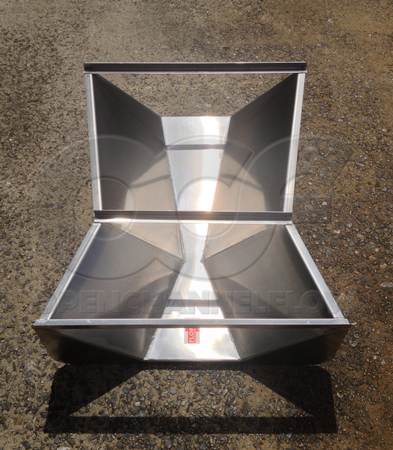
The trapezoidal shape, with sidewalls that expand as the depth increases, allows the flumes to handle a larger range of flows than other flumes of similar depth, while still retaining low flow sensitivity. Flow resolution (head for a given flow rate) does decrease as the sidewalls expand, so it is important that when using Trapezoidal Cutthroat flumes that any secondary device (flow meter) has sufficient resolution to accurate resolve the head in the flume. Pressure transducer (submerged probe) and bubbler meters are recommended.
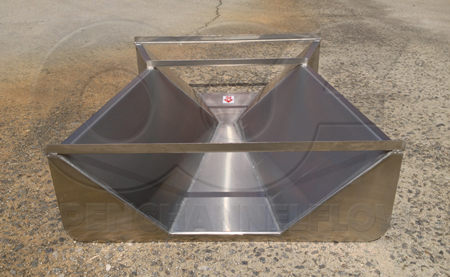
Flume Sizes
There are three sizes for the Trapezoidal Cutthroat flume. Like Rectangular Cutthroat flumes, the flumes are identical except in throat width. Throat width is as measured in the throat at the floor of the flume. All Trapezoidal Cutthroat flume are 108-inches [274.3 cm] long and 2-feet 1-7/16-inches [64.62 cm] tall.
The three throat sizes available are:
- V-Shaped (no width to the throat)
- 6-inch
- 12-inch
Flow Equations
One distinct advantage that the Trapezoidal Cutthroat flumes have over standard Trapezoidal flumes is the simple nature of the discharge equation. The discharge equation for the flumes can be expressed as:
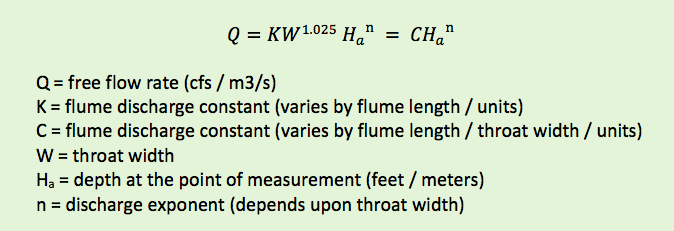
| Size | K (CFS) | K (L/S) | n |
| V-Shaped | 2.57 | 1469 | 2.53 |
| 6-inch | 3.98 | 1652 | 2.26 |
| 12-Inch | 5.48 | 1710 | 2.02 |
This is contrast to the longer, more complex used to express the discharge for most Trapezoidal flumes. Equations can, therefore, be quickly field calculated if required and can be programed into any flow meter capable of accepting a user-entered flow equation.
Note that, unlike Rectangular Cutthroat flumes, the free flow exponent does change between flume sizes even though the flumes are dimensional identical (other than height).
Flow Comparison with Trapezoidal and Rectangular Cutthroat Flumes
When comparing Trapezoidal Cutthroat to traditional Trapezoidal flumes:
The V-Shaped Trapezoidal flume slots between:
- 2-inch 30º WSC (3,474 gpm [219.2 l/s])
- 8-inch 60º (7,827 gpm [493.9 l/s])
The 6-inch and 12-inch Trapezoidal Cutthroats slot between:
- 8-inch 60º (7,827 gpm [493.9 l/s])
- 12-inch 45º SRCRC (23,898 gpm [1,508 l/s])
When compared to Rectangular Cutthroat:
The V-Shaped Trapezoidal flume slots between:
- 54-inch x 24-inch (7,220 gpm [455.6 l/s]
- 108-inch x 12-inch (8,718 gpm [550.1 l/s])
All while providing lower minimum flows (3.404 gpm [0.2148 l/s]) than either flume.
The 6-inch and 12-inch Trapezoidal Cutthroats slot between:
- 108-inch x 12-inch (8,718 gpm [550.1 l/s])
- 108-inch x 24-inch (17,711 gpm [1,118 l/s])
While ability to generate intermediate sizes of Rectangular Cutthroat flumes make it possible that a flume could be developed to cover the maximum flow rates of any of the Trapezoidal Cutthroat flume, the resultant flume would not provide the same low flow sensitivity of the Trapezoidal Cutthroat flume it was designed to replace.
Submergence
The submergence transition, st, for Trapezoidal Cutthroat flumes falls between that of Rectangular Cutthroat flumes and Trapezoidal flumes.
The submergence transitions for the flumes are:
| Size | St |
| V-Shaped | 60% |
| 6-inch | 76% |
| 12-Inch | 79% |
These submergence transition values fall within the range of those of Rectangular Cutthroat flumes (60-80%) and are not as high as those experienced by most Trapezoidal flumes (80%).
No discharge equations have been developed to correct for submergence in Trapezoidal Cutthroat flumes. As such, it is important to use the flume only in applications where it is certain that the flume will not become submerged. A similar injunction exists for Trapezoidal flumes as no submergence corrections exist, but not for Rectangular Cutthroat flumes – were corrects exist for submergence as well as lateral and longitudinal settling.



